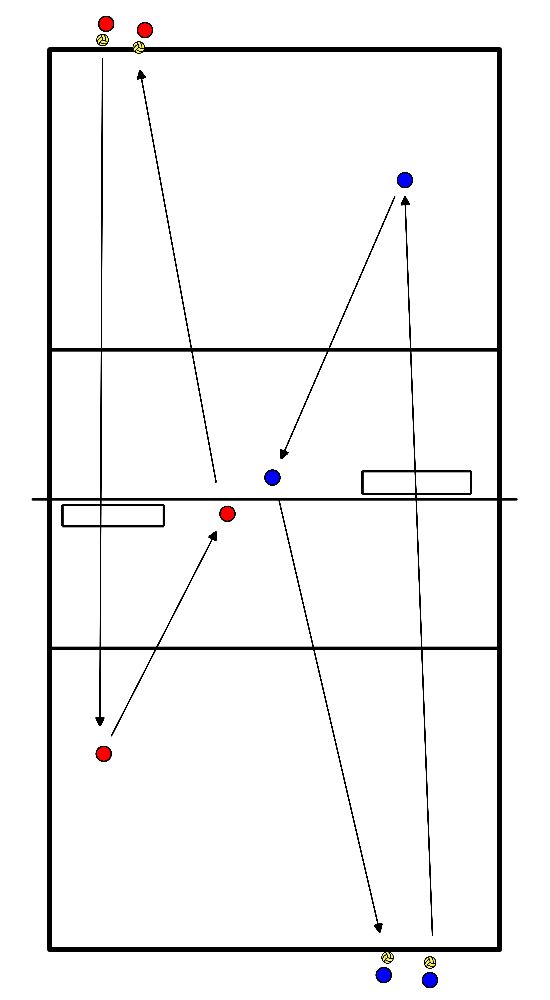Volleyball drills for technique passing / defense / reception
Some variations on the well known butterfly...:
- Service-pass-catch on SU-position, running after the ball.
- As everyone is chasing his/her ball, each player has a different task, but if desired, a player can have a fixed position.
- Variation 1:
- The SU plays a set-up to position 4, where an attacker stands to play a (placed) attack on the receiver.
- The rotation then becomes: Service -passer -upper - attacker - off-side - service etc.
- Variation 2:
- the fixed SU plays a ball to a receiver 'somewhere' in the field, who makes himself known by calling 'here'.
- The SU learns to react on sound, the receiver learns to communicate his position.
- Variation 3:
- The fixed SU plays the pass backwards to position 2, where the receiver, after an attacking movement, catches the ball and starts serving.
- In the diagram is variation 1
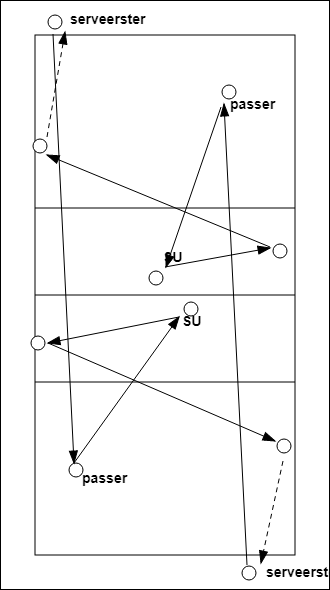
- 3 players in the middle play overhand for themselves.
- 2 players outside also play overhand for themselves.
- The outside players run around it.
- And pass in between.
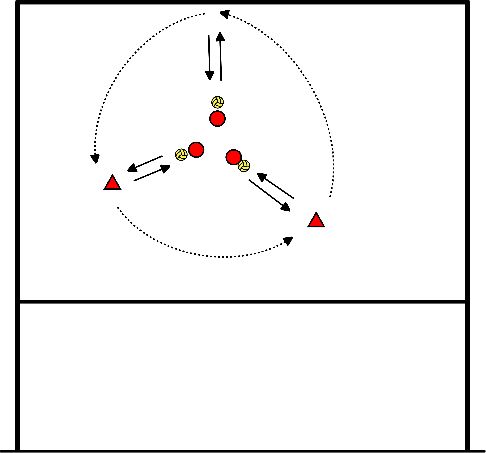
- The players stand in a diamond in the field.
- On the other side of the field, the hoops are in the corners.
- The trainer/trainer serves easily to the other side.
- On the other side, they try to pass 3 times and then try to drop down into the hoop.
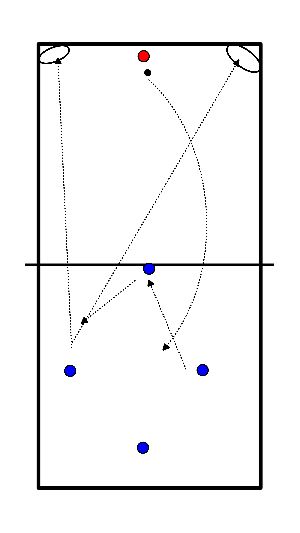
- 1 SV at mid position 3
- 1 player on position 2
- 1 player at position 4
- 2 passers backfield
- passer at position 5 --> BH to SV
- SV setup to player position 4
- passer at position 1 --> ball BH to SV
- SV setup backwards to player position 2
At 7 players --> see drawing top field and on bottom field then SV plays only 1 way.
In case of 8 players --> see drawing of upper field.
In case of 9 players --> see drawing of upper field and lower field.
In case of 10 players --> see drawing of lower field.
In case of 11 players --> then a substitute player as defender.
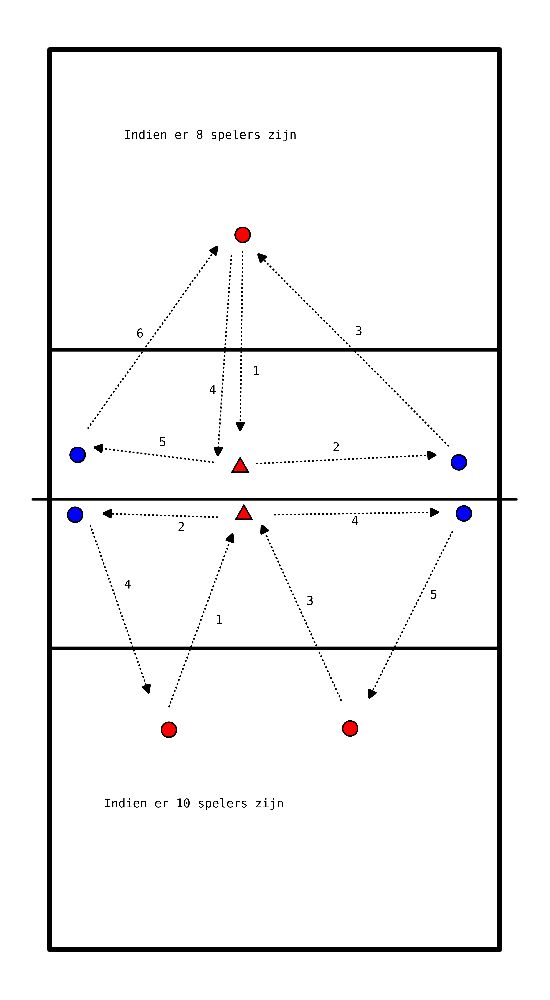
- 3 attackers
- 2 passers
- 1 backup passer
- 1 playmaker
- Trainer hits balls to the passers, after your pass you take the place of the attacker who attacked.
- Except on middle. The middle attacker stays in position and only changes with another middle.
- High tempo so change positions quickly.
- Walk-through exercise at 3 positions underhand.
- Always wait until row is finished.
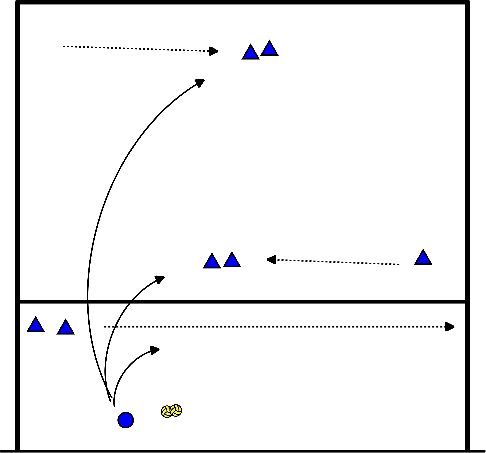
- Learning to pass to playmaker (position 2) with movement towards the ball.
- Line up at position 1.
- Players there have a ball in their hands.
- Player A plays to player B at position 3.
- Player A moves sideways to position 6.
- Player B plays the ball back to position 6.
- Player A plays the ball (preferably) BH to the korf basket at position 2.
- Player B catches the ball and joins the line at position 1.
- Player C moves into position player B.
- Player A moves to player C's position, position 3.
- On the other side of the net you can practice the same.
- Later on, alternate with player instead of basket, place of throw, position of return and position of pass.
- To learn to always pass to the distributor.
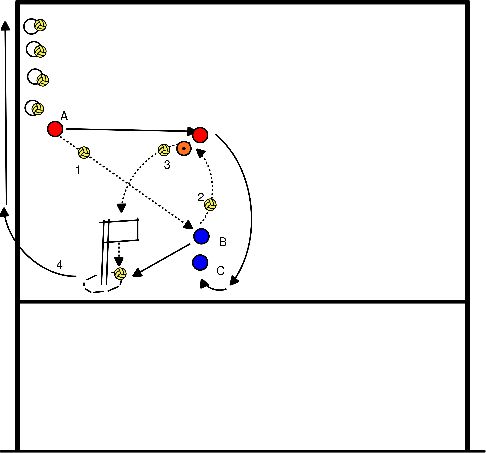
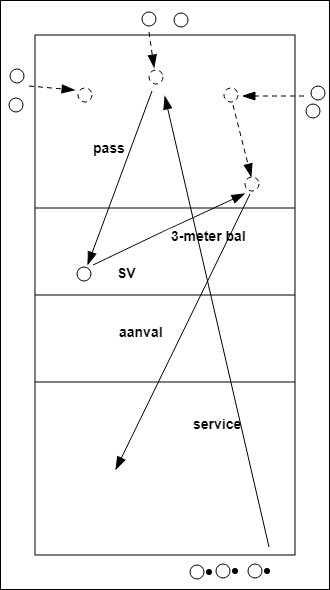
- Server hits the ball and serves.
- From the side and back three defenders quickly enter the field, one passes to the SV at the 2 position.
- He gives a three-metre pass to one of the defenders who did not pass.
- Passers swap with the reserves.
- After x times swap roles.
- Option:L the server defends the three-meter ball.
Servicepass training for 4 to 12 persons4
persons:
2 servers at the servicepoint.
1 passer1
receiver
(dynamic) same as static but dancer plays ball on receiver. Passer plays to off-setter. (server becomes reserve, reserve becomes passer, passer becomes receiver etc.)
6 persons.
2 servers3
passers1
receiver
(static) see four persons
(dynamic) server serves the ball and runs after his/her ball.
Passer passes the ball to the receiver. The player on the right becomes the server and the server
moves in on the left. Catcher becomes server. If this does not work out 1 passer becomes reserve.
Extend with fixed sv and extra player on pos 4, who will attack. Passer becomes attacker, when pass is wrong the passer goes away.
Extend with blocking.
- All players have a ball.
- Divide the group into two - maximum 4 to 5 players per group.
- Near the net is the ball pit.
- Play up overhead in front of yourself and keep playing.
- Slowly move towards the net, keep playing up.
- Overhand: Play up high, quickly get under the ball, stand still and then play.
- At the net: => play the ball IN the ball pit. The distance does not matter.
- Ball on the ground => start again from the back line.
- Ball bin on the back line of the other field, players must now pass the net. Play over it, themselves under it. Underhand or overhead no longer matters, as long as the back line is crossed.
- Practice defensive techniques.
- Improve technical attack techniques.
- Practice with drop balls.
- 1 side with block.
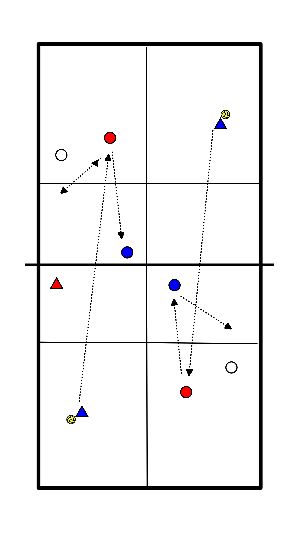
- 2 servers
- 1 passer
- 1 catcher
- Thick mat obstructs passer's view, requiring passer to focus on ball trajectory.
- Passer passes to catcher who rolls on to serveers.
- Roll through after 10 balls
